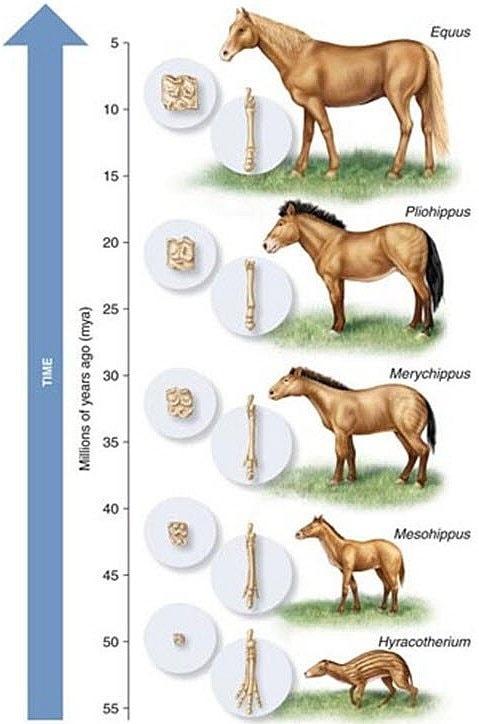Evolution- A square peg in a round hole
The evolution of the horse is probably the most documented of any animal.
The earliest form of a 'horse' recorded is Eohippus 55 millions years ago in North America. These we're much smaller than the horse we know today standing around the size of a fox. They were forest dwellers eating mainly soft leaves, berries and shoots which were reflected in their low crowned teeth. They had 5 toes, 3 of which they stood on which were padded for protection from the forest floors.
Eohippus smoothly transitioned to Orohippus over 5 million years with the most significant change seen in the teeth. The diet had changed from berries and shoots to more browsing food, so a larger grinding surface was required. The bodies had also become more slender, the hocks had moved higher off the ground (better for jumping) and the legs were starting to elongate (for running). The toes started to retract but at this stage they still had padded feet.
They continued to evolve steadily until around 40 million years ago when the climate in North America became drier and the earliest grasses and brush started to evolve. The forests started yielding to flatlands resembling modern day prairies. This gave rise to Mesohippus which had to evolve to the pressures of its environment. The teeth had to further change to manage the fibrous content of the grass and brush. Legs became longer to run from predators in open spaces and the hooves started to develop.
It is here that some travelled across the bering strait land bridge to Asia and from there to Europe. From here they evolved in many forms. Some forest dwelling, some in open grasslands. Some with hooves, some without. however it is believed that the genus equus (horse, donkey, zebra, ass) that we see today evolved from the Dinohippus. A hooved, one toed grassland browsing species located in the western eurasian steppes and the only one to survive out of all the other species.
Research suggests the most recent common ancestors of the modern day equids lived ~ 5 million years ago.
So why did this one survive over all the rest?
To ensure they were physically and emotionally safe.
They survived over all the rest.
Our modern day horse that we know today has not evolved in 5 million years. Recent DNA sequencing showed less than 1.2% difference in the DNA of a horse 28000 years ago compared to our modern day horse.
What has changed is humans.
We started domesticating them. Once kept relatively free and used as working animals we then started keeping them for leisure and paying more for them which meant we started to 'protect' them more and take away those things the horse thrived on. Friends, freedom and forage.
For a horse that has evolved to move (ALOT) and eat fibrous, low sugar food 16-18 hours a day in a herd, why then do we keep horses Isolated, Long periods in stables, limited turnout (if any), Feed single species soft grass, dairy pasture, high sugar bagged feed, the list goes on...but simultaneously expect them to run faster, jump higher and perform for extended periods at their optimum and wonder why they breakdown?
It is not hard to see, when we consider this evolution, why we have so many problems with our horses these days. We cannot change evolution. Instead we seem to be trying to squeeze a square peg into a round hole. The horses cannot change to suit us, instead they become ill.
Science tells us it would take 5000-10000 years to start to change the base genetics of a species. So a couple of 100 years of selective breeding is not going to change this. Suggesting for example the common speculation that we have 'bred the feet off thoroughbreds' may actually be down to their management.
The horses are not the problem, they've survived 55 millions years just fine. Strong feet, efficient digestive systems, aerodynamic limbs, specialised thermoregulatory systems, complex herd dynamics.
It is our ideologies as humans that are the problem, we think we know what the horse needs, The horse knows what it needs. We must look at how they have survived all these years for the answers and not rely on manufactured 'fix alls' and confinement to solve the problem. We must respect what they have evolved to be, as we sure as hell won't change it in our short lifetime.
